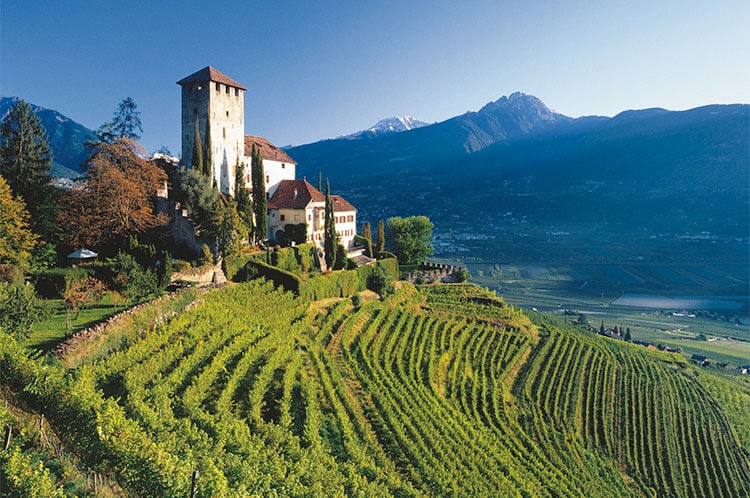• by Carri L. Wroblewski, BRIX Wine Shop •
The first time I sat at the foot of the steep, terraced slopes of Alto Adige in northern Italy was the first time I truly understood the magnitude of how difficult it must be to harvest those vineyards. The four us, my very best friends, looked up in awe knowing that no machine would ever pick those grapes—the hillside so slanted it almost looked upside down.
With Labor Day on our doorstep, it got me thinking: Who does pick those grapes? And just how labor intensive is it? Then I started thinking bigger picture. Just how much labor goes into a bottle of wine before you pour it into your glass? From the type of grape it is to the place where it grows, here are some of the world’s most labor-intensive libations.
Vines That Cling
There are some wine regions where the vineyards are painstakingly difficult to harvest due to their challenging locations. The Mosel region in Germany, which is known for its world class Riesling, has by far the most labor-intensive vineyards in the world. Rising up from the River Mosel, the vineyards here barely cling to the steep hillsides. Incapable of being harvested by machines all of the grapes are handpicked by vineyard workers. It is said that it takes seven times the amount of manpower to harvest these grapes than it does flatter vineyards sites such as the Medoc in Bordeaux. The vines in the Mosel are also trained to grow so that people working in the vineyard can do so horizontally, rather than the more arduous way, on the vertical. Still, steep is steep, and vineyard worker’s lives have been lost to the tough topography.
The Northern Rhone, one of the oldest wine producing areas in France, also boasts vineyards that are tucked into the mountainside on very narrow terraces with treacherous terrain. Here the Syrah grape reins king—think Côte-Rôtie, Cornas, and Crozes-Hermitage. Just as they do in Switzerland, because the incline is so steep, a pulley system is often utilized to transport grapes and vineyard equipment. Manual harvesting is again the only option to retrieve grapes from the extreme hillsides. However, it has its benefits. Handpicked vineyards allow for a better selection of grapes leaving unripe or rotten ones behind. Not to mention, hand harvesters use smaller containers to transfer the grapes, thus less damage is likely to occur.
The Labor is in the Process
Although tough terrain can be laborious, so too can be the way that a wine is made. Sauternes, which is a French sweet wine that hails from within the Graves region of Bordeaux, can be made from Semillon, Sauvignon Blanc, and Muscadelle grapes. The grapes for Sauternes undergo a process called botrytis cinerea, also referred to as noble rot, where the grapes become partially raisined on the vine. There is a great amount of chance taken when making Sauternes, as leaving the grapes on the vine for extended periods of time opens them up to risk of frost and rain. Also, one must then hire very skilled grape pickers to pass through the vineyards several times searching for individual grapes that have been affected by botrytis. Not only is this a costly practice, but one that is extremely labor intensive. Just one sip of the famous Sauternes Chateau d’Yquem and you’ll understand why they call it the nectar of the Gods.
Amarone della Valpolicella (typically referred to as Amarone) is another wine that requires careful selection and a timely process. Made just north of Verona—think Romeo and Juliet—in the Valpolicella region of Italy, Amarone is produced from grapes that have been partially dried. Typically a blend of Corvina and Rondinella (and also sometimes Molinara), the grapes are harvested during the first two weeks in October cluster by cluster. After selecting the best grape bunches, they are laid out on wicker mats in special drying chambers for four to five months. During that drying time (also referred to as appassimento), the grape’s mass changes and much of its water evaporates leaving only the skins, seeds, and stems. The final result after vinification is a powerful, rich, and highly aromatic red wine that begs for hearty fare. The details and time-consuming process pay off however as these wines can age for years. Try the delicious wines from famed Amarone producer, Bertani.
Managing the Grape
The grape itself can also be one of the most trying aspects in winemaking. Innately temperamental, one of the biggest culprits of this (and my favorite grape) is Pinot Noir. Grown in tightly packed clusters, this makes the grape bunches more susceptible to rot and requires vignerons to constantly oversee the vines. A low yielding grape, Pinot Noir is also notorious for its thin skins. The thin skins make it prone to fungal infections and can be easily damaged in inclement weather. Just this June a hailstorm penetrated the Côte du Beaune in France’s Burgundy region and damaged many of the vineyards. Between 50 and 90 percent of the vintage may be lost. When Mother Nature intervenes, sometimes it doesn’t matter how hard you work.
So this weekend as you uncork bottles at your end of season party, pause for a moment, and think about what it took to get that wine to our special island and into your glass.



